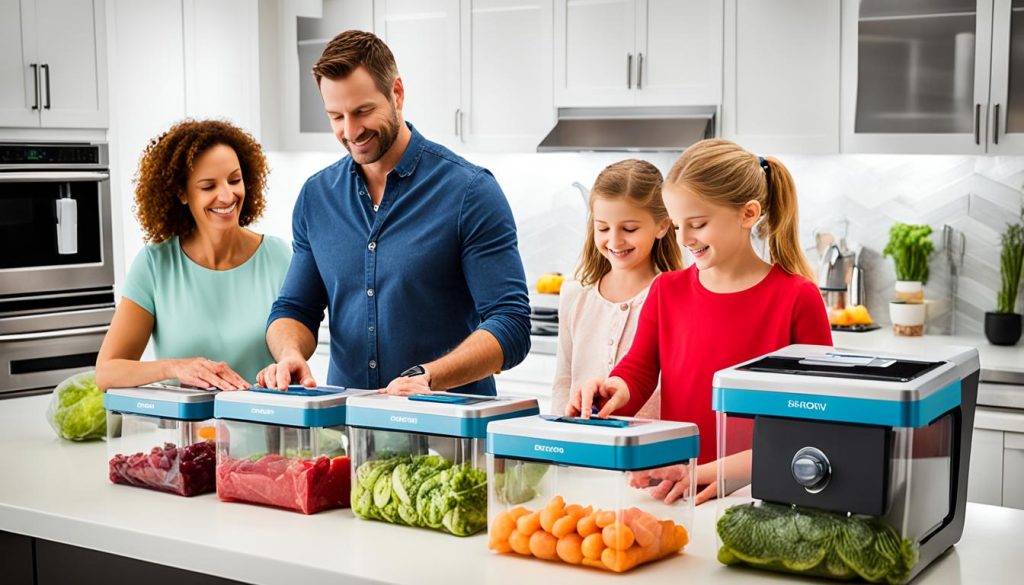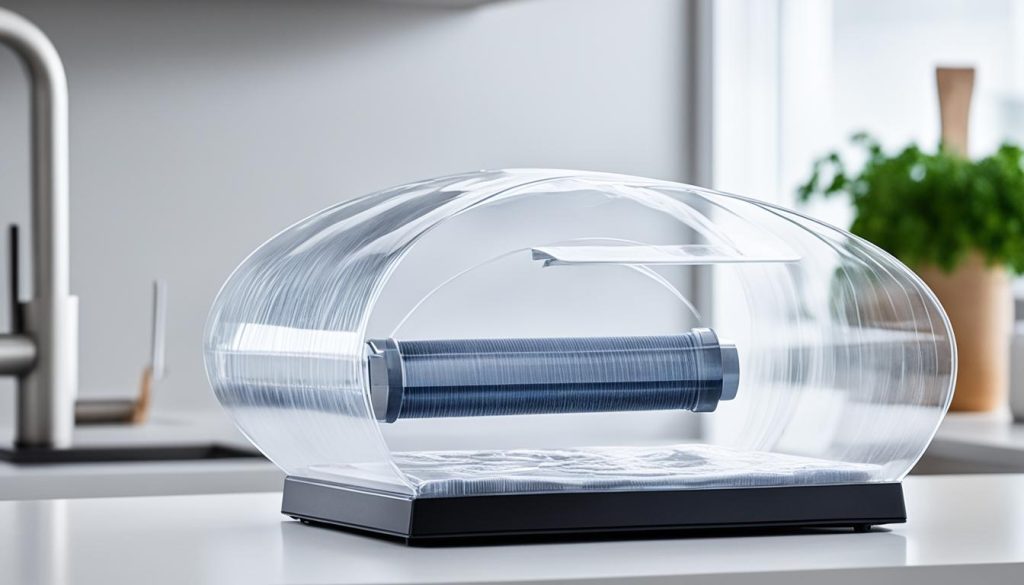Did you know that vacuum sealing food can significantly extend its shelf life and improve its overall freshness? It’s a surprising fact that highlights the remarkable impact of this food preservation method. By removing air from the package, vacuum sealing not only prevents oxidation but also inhibits the growth of harmful bacteria, leading to longer-lasting and safer food.
Key Takeaways:
- Vacuum sealing food helps extend its shelf life and maintain freshness by preventing oxidation and inhibiting bacterial growth.
- Vacuum pack machines create an airtight seal by removing air from the package, preserving the quality of refrigerated, dried, and frozen foods.
- Benefits of vacuum sealing include cost-effectiveness in meal planning and portion control, reducing food waste and saving money.
- While vacuum sealing enhances food preservation, it is crucial to follow safe food handling practices for optimal food safety.
- Proper vacuum sealing techniques and quality vacuum sealing bags or containers contribute to better food quality, flavor retention, and texture preservation.
The Benefits of Vacuum Sealing
Vacuum sealing offers several benefits for food preservation. Firstly, it provides airtight storage, preventing oxygen from coming into contact with the food and reducing oxidation, which can lead to spoilage. By creating an airtight seal, vacuum sealing helps maintain the freshness and quality of the food for longer periods.
One of the key advantages of vacuum sealing is its ability to prevent freezer burn. Freezer burn occurs when moisture evaporates from the food and forms ice crystals on its surface. This can result in a loss of flavor, texture, and overall quality. Vacuum sealing eliminates moisture and air, preventing the formation of ice crystals and significantly reducing the chances of freezer burn. You can enjoy your frozen food without worrying about unpleasant freezer burn taste.
Another benefit of vacuum sealing is its cost-effectiveness. By buying food in bulk and portioning it into individual servings, you can save money and reduce waste. Vacuum-sealed portions stay fresh for longer, allowing you to extend the shelf life of leftovers or pre-prepared meals. This not only reduces food waste but also helps you plan and control your food portions more effectively.
Whether you’re a busy parent preparing meals for the week or someone who enjoys buying in bulk to save money, vacuum sealing is a valuable solution. By vacuum sealing your food, you can enjoy the benefits of airtight storage, freezer burn prevention, cost-effectiveness, and portion control. Try vacuum sealing and experience the advantages it brings to your food preservation routine.
Key Benefits:
- Airtight storage to prevent oxidation and spoilage
- Prevention of freezer burn for better taste and quality
- Cost-effective meal planning and portion control
- Extended freshness of leftovers and bulk purchases
Vacuum Sealing Techniques for Food Safety
While vacuum sealing can enhance food preservation, it is vital to prioritize safe food handling practices to ensure food safety. The National Center for Food Preservation emphasizes the following tips when handling vacuum-sealed foods:
- Wash hands thoroughly before and during the vacuum sealing process to prevent cross-contamination.
- Utilize clean utensils and tools when handling the food to maintain hygiene.
- Maintain a clean and sanitary kitchen environment to minimize the risk of foodborne illnesses.
It is crucial to note that vacuum sealing does not replace proper food preservation methods, such as pressure canning or water-bath canning. These additional techniques are necessary for certain foods to ensure their safety and longevity.
Safe Food Handling is Crucial
Proper food handling practices are essential when vacuum sealing foods to guarantee optimal food safety. It is crucial to minimize the risk of bacterial contamination and ensure that vacuum-sealed foods remain safe for consumption.
“Safe food handling is essential to prevent foodborne illnesses and maintain the integrity of vacuum-sealed foods. By following hygiene and sanitation practices, you can enjoy the benefits of vacuum sealing without compromising your health.”
Additional Food Preservation Methods
While vacuum sealing is an effective preservation method, it is important to acknowledge that it has limitations. Some foods, particularly low-acid foods, require other preservation techniques to eliminate the risk of harmful bacteria and ensure long-term safety. Pressure canning and water-bath canning are commonly used methods to safely preserve certain foods and prevent the growth of pathogens.
By combining vacuum sealing with other preservation methods, you can maintain the quality and safety of a wide range of foods, from fruits and vegetables to meats and fish.
Comparison of Vacuum Sealing and Other Preservation Methods
| Preservation Method | Advantages | Disadvantages |
|---|---|---|
| Vacuum Sealing | – Extended shelf life – Enhanced food freshness – Prevention of freezer burn |
– Limited to certain food types – Does not eliminate the risk of botulism (low-acid foods) |
| Pressure Canning | – Suitable for low-acid foods – Eliminates the risk of botulism |
– Requires a pressure canner – Longer processing times |
| Water-Bath Canning | – Suitable for high-acid foods – Simple process |
– Limited to high-acid foods – Does not eliminate the risk of botulism (low-acid foods) |
Vacuum Sealing for Extended Shelf Life
Vacuum sealing is an effective method for extending the shelf life of various foods. By removing air from the package, vacuum sealing helps slow down the oxidation process, delaying the growth of bacteria and other microorganisms that can lead to spoilage. This makes vacuum-sealed foods last longer in both refrigeration and freezing. Whether it’s refrigerated leftovers or frozen meats and vegetables, vacuum sealing can help maintain the quality and freshness of food for an extended period.
Vacuum Sealing Methods and Tips
When it comes to vacuum sealing food, there are various methods and techniques you can use to ensure effective preservation. The most common approach is using vacuum sealing bags, which are specifically designed for this purpose. These bags create an airtight seal to keep your food fresh and extend its shelf life.
There are two main ways to seal vacuum sealing bags: using a vacuum sealing machine or a handheld vacuum sealer. The machine method offers convenience and efficiency, allowing you to seal multiple bags quickly. On the other hand, handheld vacuum sealers are portable and ideal for sealing smaller quantities or when you’re on the go.
Another option for vacuum sealing is using vacuum sealing containers. These containers provide reusable storage that keeps your food airtight and fresh. They are perfect for storing delicate or liquid-based foods that may be damaged or compromised in bags. Vacuum sealing containers are easy to use and maintain, making them a great addition to your food preservation arsenal.
When using vacuum sealing bags, it’s crucial to leave enough space at the top of the bag for sealing. This ensures a proper closure and prevents any leaks or loss of vacuum seal. Additionally, removing as much air as possible before sealing is important to maximize the effectiveness of the vacuum sealing process.
Here are some tips to follow for effective vacuum sealing:
- Make sure the sealing area of the vacuum sealing bag is clean and free from any food debris or moisture.
- Place the food in the bag and ensure it is properly positioned without obstructing the sealing area.
- Seal the bag according to the instructions provided by the manufacturer of your vacuum sealing machine or handheld sealer.
- Once sealed, check for any signs of air leakage and reseal if necessary.
- Label and date the vacuum-sealed bags or containers for easy identification and rotation.
By using the right vacuum sealing methods and following these tips, you can ensure optimal food preservation and enjoy the benefits of extended shelf life and freshness. Whether you choose vacuum sealing bags or containers, the key is to create an airtight seal that locks in the flavor, nutrients, and quality of your food.
A Comparison of Vacuum Sealing Methods
| Vacuum Sealing Method | Pros | Cons |
|---|---|---|
| Vacuum Sealing Bags |
|
|
| Vacuum Sealing Containers |
|
|
Vacuum Sealing for Better Food Quality
Vacuum sealing is a highly efficient method for preserving food and ensuring its quality remains intact. By removing oxygen from the package, vacuum sealing plays a crucial role in maintaining food freshness, flavor retention, and texture preservation.
When it comes to food freshness, vacuum sealing is a game-changer. By eliminating oxygen, a major contributor to food spoilage, vacuum sealing helps prevent oxidation, which can result in off flavors and unpleasant odors. This preservation technique allows the natural taste and aroma of the food to shine through, ensuring a delightful culinary experience.
Flavor retention is another significant benefit of vacuum sealing. By keeping food in an airtight environment, the flavors are locked in, preserving their intensity and quality for an extended period. Whether it’s a rich marinade infused into meat or the subtle sweetness of fruits, vacuum sealing helps maintain the full flavor profile of various types of food.
Texture preservation is equally important in ensuring an enjoyable eating experience, and vacuum sealing excels in this area. By preventing moisture loss, vacuum sealing helps food retain its natural moisture, preventing dryness and maintaining its tenderness and juiciness. Furthermore, it serves as a barrier against freezer burn, a common issue when storing food in the freezer for long periods. The result is food that remains succulent and satisfying, much like when it was freshly prepared.
Vacuum sealing: preserving the freshness, flavor, and texture of your favorite foods.
From meats and fish to fruits and vegetables, vacuum sealing ensures that the quality of your food remains uncompromised. Whether you’re prepping meals for the week or storing leftover portions, vacuum sealing is a reliable method for preserving food at its best.
Vacuum Sealing for Food Preservation: A Brief History
Vacuum sealing, an innovative method of food preservation, has a fascinating history that traces back to the 19th century. French chef Nicolas Appert is celebrated for pioneering food preservation techniques using hermetically sealed containers in the late 1700s. His experiments with sealing food in glass containers laid the foundation for the modern vacuum sealing we know today.
Over time, advancements in vacuum sealing technology led to the development of industrial-sized vacuum sealer machines in the 1960s. These machines revolutionized food preservation by making vacuum-sealed food safer, more convenient, and accessible for general consumption. The ability to remove air from the package minimized the risk of bacteria growth, significantly extending the shelf life of various perishable and non-perishable food items.
Vacuum sealing not only revolutionized the way food is preserved, but it also influenced how we store and consume it. By removing air from the packaging, vacuum sealing helps maintain the freshness, flavor, and texture of food. It also prevents oxidation, thereby minimizing the chances of spoilage. Whether it’s fruits, vegetables, meats, or fish, vacuum sealing has become an indispensable tool for ensuring food quality and longevity.
“The history of vacuum sealing showcases the ingenuity and innovation behind preserving food. It has transformed the way we store and extend the shelf life of perishable items, providing numerous benefits in terms of freshness, flavor, and convenience.”
Today, vacuum sealing has become commonplace both in commercial and household settings. It is widely used by food manufacturers, retailers, and individuals who value the advantages of prolonged food storage. From enhancing the freshness and taste of leftovers to efficiently portioning and preserving bulk purchases, vacuum sealing has become an instrumental technique for modern food preservation.
As vacuum sealing technology continues to evolve, we can anticipate further advancements in food preservation methods, ensuring that our cherished meals and ingredients remain fresh and flavorful for longer periods. The history of vacuum sealing serves as a testament to human innovation and our constant quest for improving food security and reducing waste.
Conclusion
Vacuum sealing is a highly effective method for preserving food by removing air from the packaging. By utilizing vacuum sealing techniques, you can extend the shelf life of your food, enhance its freshness, and prevent freezer burn. This method offers several benefits to food preservation and can be a cost-effective solution for portion control and waste reduction.
Ensuring food safety is crucial when vacuum sealing. By following safe food handling practices, such as washing hands and using clean utensils, you can maintain food quality and prevent contamination. It’s important to note that vacuum sealing does not replace traditional food preservation methods such as canning, but it does complement these methods, resulting in longer-lasting and better-preserved food.
Whether you’re preserving leftovers, planning meals in advance, or buying food in bulk, vacuum sealing is a valuable tool. It allows you to maintain the quality and longevity of your food while enjoying the benefits of extended shelf life and enhanced freshness. To learn more about the science behind vacuum sealing, you can read this study conducted by experts in the field.


